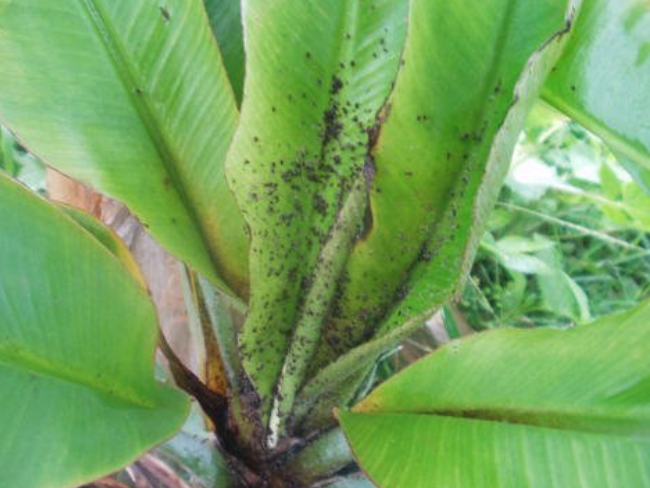Banana aphid (Pentalonia nigronervosa)
Credit: Biovision-Infonet
Banana aphids (Pentalonia nigronervosa) often gather on the youngest leaves of young plants. They may form large colonies where they are uncontrolled and protected by ants. They feed by piercing the plant cells with a syringe-like mouthpart.
Colony of banana aphids feeding on a young banana plant (highly magnified), real size 1-2mm. Ants feed on the liquid honeydew excreted by the aphids, manage the aphid colony, and protect the aphid colony from enemies.
It is a small aphid about 1-2 mm long and blackish-brown in colour. Colonies are usually present on the base of young leaves. The direct damage caused by aphids sucking the plant sap is negligible. However, they are important pests as vectors of the virus causing the bunchy-top disease.
Large colonies of aphids can occur around the base of pseudostems, down to 7-8 cm below the soil surface. Dense colonies can also occur between the sheath of outer leaf and pseudostem. During drought, aphids seek sheltered locations on the plant. In dull and humid weather, however, aphids may spread to foliage generally, and to the bases of maturing hands of fruit and all over the hands of young fruit.
Colonies of P. nigronervosa are attended by ants, which feed on the large quantity of honeydew produced. Many species of ant are involved worldwide. Stechmann et al. (1996) described how ant-attendance reduced the density of indigenous predators of P. nigronervosa considerably, which has implications for biological control (Wellings et al., 1994). Ants also transport aphids from plant to plant, establishing new infestations.
P. nigronervosa is not normally found on plantains, suggesting that they may have resistance to the aphid.
What to do:
- Conserve natural enemies. They are important in natural control of aphids. For more information on Natural enemies click here
- Monitor the crop regularly

